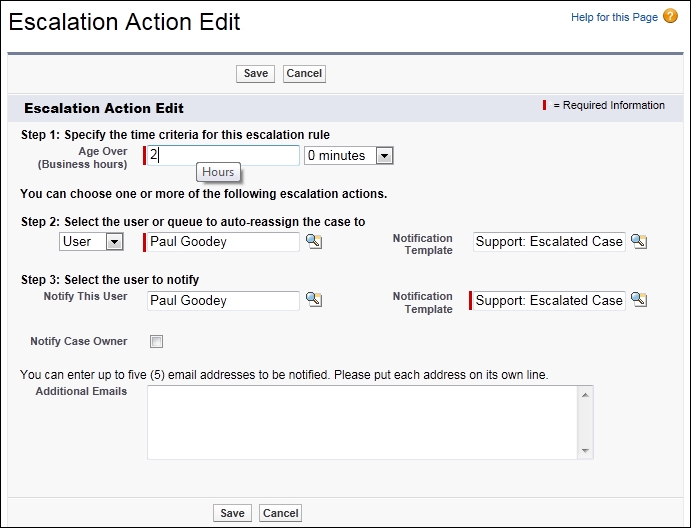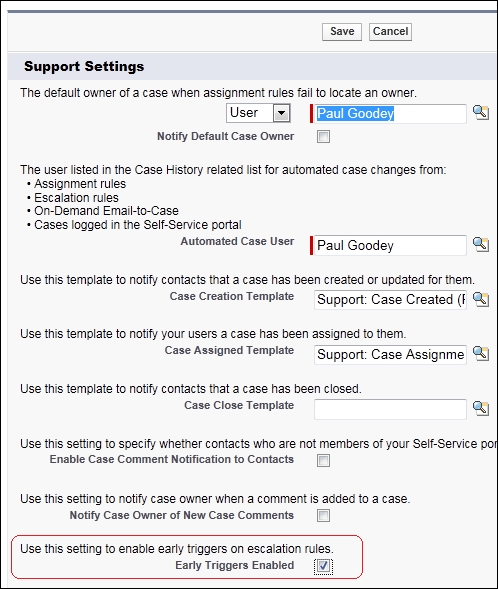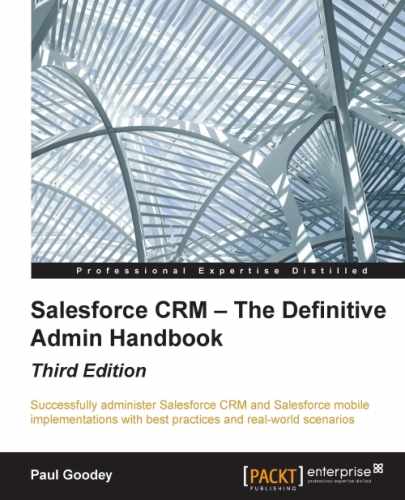At the core of the service cloud in Salesforce CRM is the case management functionality that tracks and records activities dealing with customer, service, and support automation. Case records, in Salesforce, are associated with contacts and/or accounts.
A case is a detailed description of a customer's feedback, problem, or question. Your organization can use cases to track and solve your customers' issues. Cases can be manually entered from within the Cases tab by the support or sales team after, say, a phone call or e-mail to or from a customer. However, you can also set up more complex Web-to-Case and Email-to-Case to obtain customer responses from your company's website and customer e-mails.
There are number of ways case records, which might consist of recorded phone calls or e-mail communications, can be entered into the Salesforce CRM application. Case records can be entered manually by the users accessing the Case tab, but there are other methods available for you to consider, which include:
- Automatic creation from an e-mail using Mail-to-Case sent by a customer
- Automatic creation from a web form using Web-to-Case entered by a customer
The Email-to-Case feature provides the facility for automatic case creation when an e-mail is sent to a preconfigured e-mail address.
The Web-to-Case feature provides the facility where customers can submit support cases online.
When setting up Web-to-Case, autoresponse rules can be created that use e-mail templates to send an acknowledging e-mail to customers who have created cases using the web form.
Queues can be thought of as a storage location to group cases together—usually by a geographic region or business function. Cases remain in the queue until they are assigned or accepted by users.
Whenever you create a case queue, Salesforce automatically generates a case list view to enable users to access the records in the queue.
Case records can be assigned to queues manually or automatically using assignment rules. Case queues and assignment rules are very similar to the queues and assignment rules available for leads.
Only one case assignment rule can be active at any one time, and each rule can contain multiple criteria—up to a maximum of 25 criteria.
Escalation rules are used to automatically escalate an unresolved case within a certain period of time. This escalation is triggered on the Age Over setting (when the Age field is overdue).
The modification of a field on a case is the only thing that stops the clock for escalation rules if the rule is set to "disable after first modified" or is based on the last modification time of the case.
Note
For each escalation rule, you can specify up to five actions to escalate the case over increasing periods of time.
The Age Over field specifies the number of hours after which a case should be escalated if it has not been closed.
This time is calculated from the date field set in the Specify how escalation times are set field.
No two escalation actions can have the same time period set.
Sending an e-mail to a customer from the case record does not reset the case escalation. Only when the record is changed, and not a related list, is the case escalation time reset.
Escalation rules use business hours to determine when to escalate a case. The case feature can include business hours in multiple time zones and can associate cases to various time zones.
Each escalation rule can have multiple criteria settings and up to five escalation actions per entry. An example of one such action is shown in the following screenshot:

The early triggers mechanism enables case escalation to get expedited to the previous quarter hour slot. The setting is activated for the organization as a whole and is used to ensure that customer Service Level Agreements (SLAs) are met.
The early triggers on the escalation box allow you to specify whether cases should escalate sooner than the Age Over time specified.
As an example, let's say that the escalation logic is currently running on the hour and the escalation triggers are fired every 15 minutes.
Now, say, a case is created at 16:16 and the Escalation Rule is set to trigger after one hour; the case will not be escalated until 17:30 because it missed the 17:15 escalation trigger by one minute. This can be an issue when precise escalation is required and hence, by enabling early triggers, this issue can be eliminated.
To enable the early triggers in the escalation box, navigate to Setup | Customize | Cases | Support Settings. Now, click on Edit and set the Early Triggers Enabled checkbox as shown next, and then click on the Save button.

